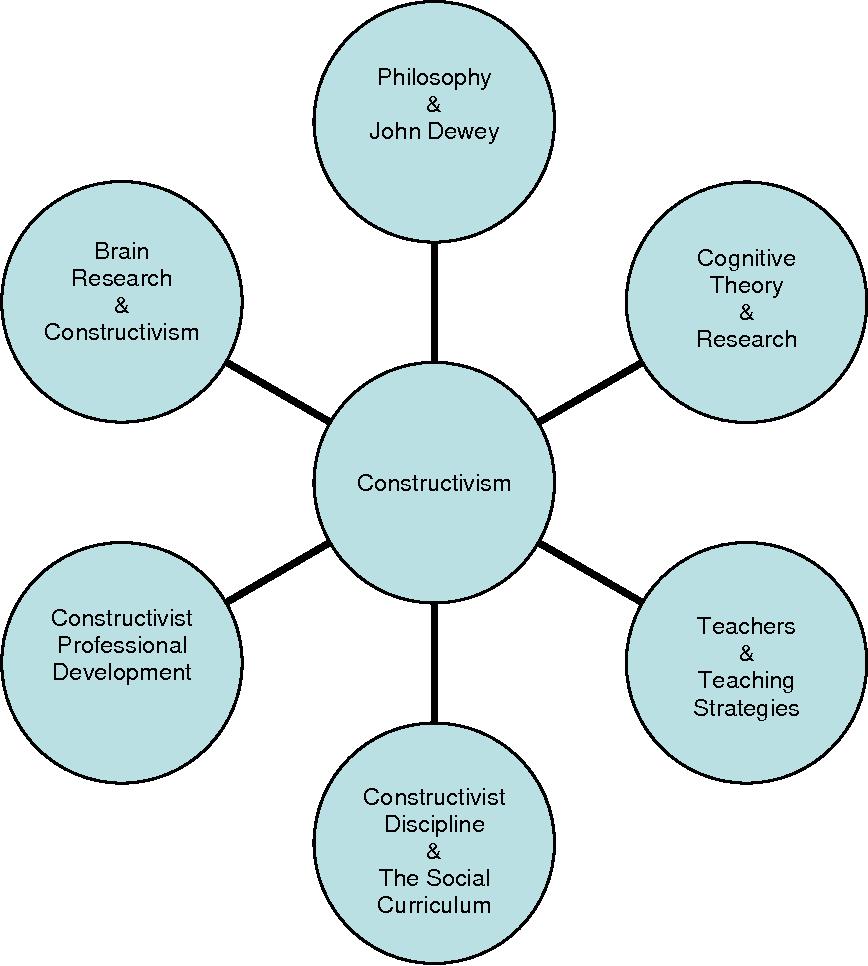Theoreticalintroduction
Schema,assimilation,compliance,balance
Assimilationreferstotheprocessoffilteringorchangingthestimulusinputbythelearningindividual.Thatistosay,whentheindividualfeelsstimuli,heincorporatesthemintotheoriginalschemainhismind,makingitapartofhimself.
Adaptationreferstotheprocessofreorganizationandtransformationofchildren’scognitivestructurecausedbychangesintheexternalenvironmentandtheoriginalcognitivestructurecannotassimilatetheinformationprovidedbythenewenvironment.Theprocessofchangeundertheinfluenceofexternalstimuli.
Balancereferstotheprocessinwhichindividuallearnersmakethecognitivedevelopmentfromoneequilibriumstatetoanotherthroughtheself-regulationmechanism.
Thedevelopmenthistoryofconstructivism
Themainrepresentativesofconstructivismtheoryare:Piaget(J.Piaget),Kohlberg(O.Kernberg),Sternberg(RJsternberg),Katz(D.Katz),Vygotsky(Vogotsgy).
J.Piagetisoneofthemostinfluentialpsychologistsinthefieldofcognitivedevelopment.Theschoolhefoundedonchildren'scognitivedevelopmentiscalledtheGenevaSchool.Piaget’sbasicviewofconstructivismisthatchildrengraduallyconstructknowledgeabouttheexternalworldintheprocessofinteractingwiththesurroundingenvironment,soastodeveloptheirowncognitivestructure.Theinteractionbetweenchildrenandtheenvironmentinvolvestwobasicprocesses:"assimilation"and"adaptation".Assimilationreferstotheprocessbywhichindividualsintegratetheinformationprovidedbyexternalstimuliintotheiroriginalcognitivestructure;adaptationreferstotheprocessbywhichindividuals'cognitivestructurechangesduetotheinfluenceofexternalstimuli.Assimilationistheexpansionofthenumberofcognitivestructures,andadaptationisthechangeinthenatureofcognitivestructures.Thecognitiveindividualachievesbalancewiththesurroundingenvironmentthroughthetwoformsofassimilationandadaptation:whenthechildcanusetheexistingschematoassimilatenewinformation,heisinabalancedcognitivestate;andwhentheexistingschemacannotWhenassimilatingnewinformation,thebalanceisdestroyed,andtheprocessofmodifyingorcreatinganewschema(adaptation)istheprocessoffindinganewbalance.Children'scognitivestructureisgraduallyconstructedthroughtheprocessofassimilationandadaptation,andiscontinuouslyenriched,improvedanddevelopedinthecycleof"balance-imbalance-newbalance".
OnthebasisofPiaget’s"cognitivestructuretheory",O.Kernberghasmadefurtherresearchonthenatureanddevelopmentconditionsofcognitivestructure;SternBerg(RJsternberg)andKatz(D.Katz)andothersemphasizedthekeyroleofindividualinitiativeintheprocessofconstructingcognitivestructure,andmadeseriousexplorationsonhowtoexertindividualinitiativeinthecognitiveprocess;The"CulturalandHistoricalDevelopmentTheory"putforwardbyVogotsgyemphasizestheroleofthesocial,culturalandhistoricalbackgroundofthelearnerinthecognitiveprocess,andputsforwardthetheoryofthe"recentdevelopmentzone".Vygotskybelievesthatindividuallearningiscarriedoutunderacertainhistorical,socialandculturalbackground,andsocietycanplayanimportantroleinsupportingandpromotingindividuallearninganddevelopment.Vygotskydistinguishestwolevelsofindividualdevelopment:theactuallevelofdevelopmentandthepotentiallevelofdevelopment.Theactuallevelofdevelopmentreferstothelevelthatanindividualcanachievebyindependentactivities,whilethepotentiallevelofdevelopmentreferstothelevelofindividualThelevelofactivitythatcanbeachievedwiththehelpofhismatureindividual,theareabetweenthesetwolevelsisthe"zoneofnearestdevelopment."Onthisbasis,theVereiroSchoolheadedbyVygotskyhasthoroughlystudiedtheimportantroleof"activity"and"socialcommunication"inthedevelopmentofhumanadvancedpsychologicalfunctions.Allthesestudieshavefurtherenrichedandperfectedthetheoryofconstructivism,andcreatedconditionsforpracticalapplicationintheteachingprocess.
Thecontentofconstructivismtheoryisveryrich,butitscorecanbesummarizedinonesentence:student-centered,emphasizingstudents'activeexplorationofknowledge,activediscoveryandactiveconstructionofthemeaningoftheknowledgelearned(Insteadofjusttransferringknowledgefromtheteacher’smindtothestudent’snotebook,asintraditionalteaching).Thestudent-centeredemphasisison"learning";theteacher-centeredemphasisison"teaching".Thisisthemostfundamentalpointofdivergencebetweenthetwoeducationalthoughtsandteachingconcepts,fromwhichtwoopposinglearningtheories,teachingtheoriesandteachingdesigntheorieshavebeendeveloped.Becausethelearningenvironmentrequiredbyconstructivismisstronglysupportedbythelatestinformationtechnologyachievements,thetheoryofconstructivismisincreasinglyintegratedwiththeteachingpracticeofteachers,andithasbecometheguidingideologyofdeepeningteachingreforminschoolsathomeandabroad.
LearningTheory
ConstructivistLearningTheory
Constructivismoriginatesfromthetheoryofchildren’scognitivedevelopment,becausetheindividual’scognitivedevelopmentiscloselyrelatedtothelearningprocessTherefore,theuseofconstructivismcanbetterexplainthecognitivelawsofthehumanlearningprocess,thatis,itcanbetterexplainhowlearningoccurs,howmeaningisconstructed,howconceptsareformed,andwhatmajorfactorsshouldbeincludedinanideallearningenvironment,andsoon.Inshort,undertheguidanceofconstructivism,asetofnewandmoreeffectivecognitivelearningtheoriescanbeformed,andamoreidealconstructivistlearningenvironmentcanberealizedonthisbasis.
Thebasiccontentofconstructivistlearningtheorycanbecarriedoutfromtwoaspects:"themeaningoflearning"(thatis,about"whatislearning")and"themethodoflearning"(thatis,about"howtolearn").illustrate.
Aboutthemeaningoflearning
Constructivismbelievesthatknowledgeisnotimpartedbyteachers,butlearnersinacertaincontext,thatis,thesocialandculturalbackground,Learningistheprocessofacquiringknowledgewiththehelpofothers(includingteachersandlearningpartners),usingnecessarylearningmaterials,andobtainingitthroughmeaningconstruction.Sincelearningisaprocessofmeaningconstructionachievedthroughinterpersonalcollaborationactivitieswiththehelpofotherpeopleinacertaincontext,thatis,asocialandculturalbackground,theconstructivistlearningtheorybelievesthat“situation”,“collaboration”,“conversation”and"Senseconstruction"isthefourmajorelementsorattributesinthelearningenvironment."Context":Thecontextinthelearningenvironmentmustbeconducivetotheconstructionofthemeaningofthecontentlearnedbythestudents.Thisputsforwardnewrequirementsforinstructionaldesign.Inotherwords,inaconstructivistlearningenvironment,instructionaldesignmustnotonlyconsidertheanalysisofteachingobjectives,butalsoconsiderthecreationofsituationsthatareconducivetotheconstructionofmeaningforstudents,andlookatthecreationofsituations.Workisoneofthemostimportantcontentsofinstructionaldesign."Collaboration":Collaborationoccursthroughoutthelearningprocess.Collaborationplaysanimportantroleinthecollectionandanalysisoflearningmaterials,theformulationandverificationofhypotheses,theevaluationoflearningresults,andthefinalconstructionofmeaning."Conversation":Conversationisanindispensablepartofthecollaborationprocess.Themembersofthestudygroupmustdiscusshowtocompletetheprescribedlearningtaskplanthroughconversation;inaddition,thecollaborativelearningprocessisalsoaconversationprocess,inthisprocess,eachlearner'sthinkingresults(wisdom)aresharedbytheentirelearninggroup,soConversationisoneoftheimportantmeanstoachievemeaningconstruction."Senseconstruction":Thisistheultimategoaloftheentirelearningprocess.Themeaningtobeconstructedrefersto:thenatureandlawsofthingsandtheinternalconnectionsbetweenthings.Tohelpstudentsconstructmeaninginthelearningprocessistohelpstudentsachieveadeeperunderstandingofthenatureandlawsofthethingsreflectedinthecurrentlearningcontentandtheinternalconnectionsbetweenthethingsandotherthings.Thelong-termstorageformofthisunderstandinginthebrainistheaforementioned"schema",whichisthecognitivestructureofwhatiscurrentlybeinglearned.Fromthemeaningof"learning"mentionedabove,itcanbeseenthatthequalityoflearningisafunctionofthelearner'sabilitytoconstructmeaning,notafunctionofthelearner'sabilitytoreproducetheteacher'sthinkingprocess.Inotherwords,theamountofknowledgeacquireddependsonthelearner’sabilitytoconstructthemeaningoftheknowledgebasedonhisownexperience,ratherthanonthelearner’sabilitytomemorizeandrecitewhattheteacherteaches.
Aboutlearningmethods
Constructivismadvocateslearner-centeredlearningundertheguidanceofteachers,thatis,itemphasizeslearnersTheroleofthecognitivesubjectofthecognitiondoesnotneglecttheguidingroleoftheteacher.Theteacheristhehelperandpromoterofmeaningconstruction,ratherthantheimparterandindoctrinatorofknowledge.Studentsarethemainbodyofinformationprocessingandtheactiveconstructorofmeaning,ratherthanthepassiverecipientsandindoctrinatedobjectsofexternalstimuli.Tobecomeactivebuildersofmeaning,studentsarerequiredtoplayamajorroleinthelearningprocessfromthefollowingaspects:
(1)Useexplorationanddiscoverymethodstoconstructthemeaningofknowledge;
p>(2)Intheprocessofconstructingmeaning,studentsarerequiredtoactivelycollectandanalyzerelevantinformationandmaterials,putforwardvarioushypothesesandtrytoverifytheproblemstheyarelearning;
(3)Trytoconnectthethingsreflectedinthecurrentlearningcontentwiththethingsyoualreadyknow,andthinkaboutthisconnectionseriously."Connecting"and"thinking"arethekeytomeaningconstruction.Iftheprocessofconnectionandthinkingcanbecombinedwiththenegotiationprocess(thatis,theprocessofcommunicationanddiscussion)incollaborativelearning,studentswillbemoreefficientinconstructingmeaningandbetterinquality.Therearetwotypesofnegotiation:"self-negotiation"and"mutualnegotiation"(alsocalled"internalnegotiation"and"socialnegotiation").Self-negotiationreferstoarguingwithoneselfaboutwhatiscorrect;mutualnegotiationreferstothemutualnegotiationwithinthestudygroupDiscussionanddebate.
Ifateacherwantstobeahelperforstudentstoconstructmeaning,teachersarerequiredtoplayaguidingroleintheteachingprocessfromthefollowingaspects:
(1)Stimulatestudents’interestinlearningandhelpStudentsformlearningmotivation;
(2)Helpstudentsconstructthemeaningofcurrentknowledgebycreatingcontextsthatmeettherequirementsofteachingcontentandpromptingtheconnectionbetweennewandoldknowledge;
(3)Inordertomakemeaningconstructionmoreeffective,teachersshouldorganizecollaborativelearning(conductdiscussionsandexchanges)whenpossible,andguidethecollaborativelearningprocesstodevelopinadirectionthatisconducivetomeaningconstruction.Guidancemethodsinclude:askingappropriatequestionstoarousestudents’thinkinganddiscussion;tryingtodeepentheproblemstepbystepinthediscussiontodeepenthestudents’understandingofthecontent;inspiringandinducingstudentstodiscovertherulesandcorrectthembythemselvesAndsupplementthewrongorone-sidedunderstanding.
TeachingThoughts
Theteachingthoughtscontainedinconstructivismaremainlyreflectedintheviewofknowledge,theviewoflearning,theviewofstudents,thepositioningandroleofteachersandstudents,thelearningenvironmentandteachingprinciples,etc.6aspects.
Constructivistviewofknowledge
(1)Knowledgeisnotapurelyobjectivereflectionofreality,norisanykindofsymbolsystemthatconveysknowledgeAbsolutelytruerepresentation.Itisjustanexplanation,hypothesisorhypothesisoftheobjectiveworldbypeople.Itisnotthefinalanswertothequestion.Itwillinevitablyundergocontinuoustransformation,sublimationandrewritingaspeople'sunderstandingdeepens,andnewexplanationsandhypotheseswillappear.
(2)Knowledgecannotsummarizethelawsoftheworldabsolutelyandaccurately,andprovidepracticalmethodsforanyactivityorproblemsolving.Inthesolutionofspecificproblems,knowledgecannotbeaccurateandeffectivewhenused.Instead,theoriginalknowledgeneedstobereprocessedandrecreatedaccordingtothesituationofthespecificproblem.
(3)Knowledgecannotexistoutsidetheindividualintheformofanentity.Althoughacertainexternalformisgiventoknowledgethroughlanguage,andithasgainedmoregeneralrecognition,thisdoesnotmeanlearningThereadershavethesameunderstandingofthiskindofknowledge.Realunderstandingcanonlybeconstructedbylearnersthemselvesbasedontheirownexperiencebackground,anddependsontheprocessoflearningactivitiesunderspecificcircumstances.Otherwise,itisnotcalledcomprehension,butrotememorizationorrotelearning,whichispassivecopyinglearning.
Constructivistviewoflearning
(1)Learningisnotaprocessinwhichteacherssimplytransferknowledgetostudents,butisaprocessbywhichstudentsconstructknowledgethemselves.Studentsdonotsimplyreceiveinformationpassively,butactivelyconstructthemeaningofknowledge.Thisconstructioncannotbereplacedbyothers.
(2)Learningisnottopassivelyreceiveinformationstimulation,buttoactivelyconstructmeaning.Itistoactivelyselect,processandprocessexternalinformationaccordingtoone'sownexperiencebackground,soastoobtainone'sownmeaning.Externalinformationitselfhasnomeaning.Themeaningisconstructedbylearnersthroughtherepeatedandtwo-wayinteractionprocessbetweennewandoldknowledgeandexperience.Therefore,learningisnotlikethe"stimulusresponse"describedbybehaviorism.
(3)Theacquisitionoflearningmeaningisthateachlearnerre-recognizesandencodesnewinformationbasedonhisownoriginalknowledgeandexperience,andconstructshisownunderstanding.Inthisprocess,thelearner'soriginalknowledgeandexperienceareadjustedandchangedduetotheentryofnewknowledgeandexperience.
(4)Assimilationandadaptationaretwowaysorwaysthatlearners'cognitivestructurechanges.Assimilationisthequantitativechangeofcognitivestructure,whileadaptationisthequalitativechangeofcognitivestructure.Assimilation-Adaptation-Assimilation-Adaptation...cyclical,balance-imbalance-balance-imbalance,mutualalternation,thedevelopmentofhumancognitivelevel,issuchaprocess.Learningisnotasimpleaccumulationofinformation,butmoreimportantly,itcontainstheconflictbetweenoldandnewknowledgeandexperience,andthereorganizationofthecognitivestructurecausedbythis.Thelearningprocessisnotsimpleinformationinput,storageandextraction,butatwo-wayinteractionprocessbetweennewandoldknowledgeandexperience,thatis,theprocessofinteractionbetweenthelearnerandthelearningenvironment.
Constructivistviewofstudents
(1)Constructivismemphasizesthatlearnersdonotenterthelearningsituationwiththeirheadsempty.Indailylifeandvariousformsoflearninginthepast,theyhaveformedrelevantknowledgeandexperience,andtheyhavetheirownviewsoneverything.Eveniftherearesomeproblemstheyhaveneverbeenincontactwithandthereisnoready-madeexperiencetolearnfrom,butwhentheproblemispresentedtothem,theywillstillformanexplanationoftheproblembasedontheirpastexperienceandrelyontheircognitiveabilities,andputforwardtheirownideas.Hypothesis.
(2)Teachingcannotignorethelearners’existingknowledgeandexperience,andsimplyandforcefullyimplementknowledge"filling"oflearnersfromtheoutside,butshouldtakethelearners’originalknowledgeandexperienceasnewThegrowthpointofknowledgeguideslearnerstogrownewknowledgeandexperiencefromtheoriginalknowledgeandexperience.Teachingisnotthetransferofknowledge,buttheprocessingandconversionofknowledge.Teachersarenotonlythepresenterofknowledge,notasymbolofknowledgeauthority,butshouldattachimportancetostudents'ownunderstandingofvariousphenomena,listentotheircurrentviews,thinkabouttheoriginoftheirideas,andusethisasabasistoguidestudentstoenrichoradjustOwnexplanation.
(3)Teachersandstudents,studentsandstudentsneedtoexploresomeproblemstogether,andcommunicateandquestioneachotherintheprocessofexploration,andunderstandeachother'sideas.Duetotheinevitabledifferencesinexperiencebackground,learners'viewsandunderstandingoftheproblemareoftenvastlydifferent.Infact,inthestudentcommunity,thesedifferencesthemselvesareavaluablephenomenonresource.Althoughconstructivismattachesgreatimportancetoindividualself-development,hedoesnotdenyexternalguidance,thatis,theinfluenceofteachers.
Theroleandfunctionofteachersandstudents
(1)Theroleofteachersisaloyalsupporterofstudents'knowledgeconstruction.Theroleoftheteacherhaschangedfromthetraditionalauthorityofknowledgetransfertothetutorofstudentlearning,becomingtheseniorpartnerorcollaboratorofstudentlearning.Teachersshouldprovidestudentswithcomplexrealquestions.Notonlymusttheydevelopordiscovertheseproblems,buttheymustalsorecognizethattherearemultipleanswerstocomplexproblems,andencouragestudentstohavemultipleviewsonproblemsolving.Thisisobviouslyincloseagreementwiththepurposeofcreativeteachingactivities.Teachersmustcreateagoodlearningenvironmentinwhichstudentscanstarttheirlearningthroughexperiments,independentexploration,cooperativelearning,etc.Teachersmustensureabalancebetweenlearningactivitiesandlearningcontent.Teachersmustprovidestudentswithmetacognitivetoolsandpsychologicalmeasurementtools,cultivatestudents'criticalcognitiveprocessingstrategies,andconstructtheirownmentalmodelsofknowledgeandunderstanding.Teachersshouldrecognizethatteachinggoalsincludecognitivegoalsandemotionalgoals.Teachingisaprocessofgraduallyreducingexternalcontrolandincreasingstudents'self-controlledlearning.
(2)Ifteacherswanttobeactivehelpersandguidesforstudentstoconstructknowledge,theyshouldstimulatestudents'interestinlearning,andarouseandmaintainstudents'learningmotivation.Bycreatingscenariosthatmeettherequirementsoftheteachingcontentandcluesthatsuggesttheconnectionbetweenthenewandtheoldknowledge,ithelpsstudentsconstructthemeaningofthecurrentknowledge.Inordertomakestudents'meaningconstructionmoreeffective,teachersshouldorganizecollaborativelearningasmuchaspossible,launchdiscussionsandexchanges,andguidethecollaborativelearningprocesstodevelopinadirectionthatisconducivetomeaningconstruction.
(3)Theroleofstudentsistobeanactiveparticipantinteachingactivitiesandanactivebuilderofknowledge.Constructivismrequiresstudentstofacecomplexreal-worldsituationsandcompletetasksincomplexreal-worldsituations.Therefore,studentsneedtoadoptanewlearningstyleandnewcognitiveprocessingstrategiestoformthattheyareknowledgeableandunderstandable.Thementalmodeloftheconstructor.Constructivistteachingrequiresstudentstotakeonmoreopportunitiestomanagetheirownlearningthantraditionalteaching;teachersshouldpayattentiontokeepingtheopportunitiesalwaysinthe"student'srecentdevelopmentzone"proposedbyVygotsky,andprovidestudentswithcertainguidance.
Studentsshoulduseexplorationanddiscoverytoconstructthemeaningofknowledge.Intheprocessofconstructingmeaning,studentsarerequiredtoactivelycollectandanalyzerelevantinformation,putforwardvarioushypothesesontheproblemstheyhavelearned,andtrytoverifythem.Wemustbegoodatlinkingthecurrentlearningcontentwithourownknowledgeandexperienceasmuchaspossible,andcarefullyconsiderthislink.Connectionandthinkingarethekeytomeaningconstruction.Itsbesteffectistointegratewiththenegotiationprocess.
Constructivistlearningenvironment
Constructivismbelievesthattheknowledgeoflearnersisthehelpofothersundercertaincircumstances,suchaspeopleandpeopleCollaboration,communication,useofnecessaryinformation,etc.,areobtainedthroughtheconstructionofmeaning.Theideallearningenvironmentshouldincludefourparts:context,collaboration,communicationandmeaningconstruction.
(1)Context,thecontextinthelearningenvironmentmustbeconducivetotheconstructionofthemeaningofthelearner'scontent.Ininstructionaldesign,creatingacontextthatfacilitatestheconstructionofmeaningforlearnersisthemostimportantlinkoraspect.
(2)Collaborationshouldrunthroughtheentirelearningactivityprocess.Thecollaborationbetweenteachersandstudents,andbetweenstudentsandstudentsplaysaveryimportantroleinthecollectionandanalysisoflearningmaterials,theformulationandverificationofhypotheses,theself-feedbackofthelearningprocess,theevaluationoflearningresults,andthefinalconstructionofmeaning.Collaborationisasenseofnegotiationinacertainsense.Negotiationmainlyincludesself-negotiationandmutualnegotiation.Self-negotiationmeansthatoneselfandoneselfrepeatedlydiscusswhatismorereasonable;mutualnegotiationmeansthediscussion,discussionanddebatewithinthestudygroup.
(3)Communicationisthemostbasicwayorlinkintheprocessofcollaboration.Forexample,themembersofthelearninggroupmustdiscusshowtocompletetheprescribedlearningtaskstoachievethegoalofmeaningconstructionthroughcommunication,andhowtoobtainmoreguidanceandhelpfromteachersorothers.Infact,theprocessofcollaborativelearningisaprocessofcommunication.Inthisprocess,theideasofeachlearneraresharedbytheentirelearninggroup.Communicationisavitalmeanstopromotethelearningprocessofeachlearner.

(4)Meaningconstructionistheultimategoaloftheteachingprocess.Themeaningofitsconstructionreferstothenatureandlawsofthingsandtheinternalconnectionsbetweenthings.Tohelpstudentsconstructmeaninginthelearningprocessistohelpstudentsachieveadeeperunderstandingofthenatureandlawsofthingsreflectedinthecurrentlearningcontentandtheinternalconnectionsbetweenthethingsandotherthings.
Theteachingprincipleofconstructivism
(1)Putalllearningtasksinthelearninginordertobeabletoadapttotheworldmoreeffectively.
(2)Theteachinggoalsshouldbeconsistentwiththegoalsinthestudents'learningenvironment,andtheproblemsidentifiedbytheteachershouldmakethestudentsfeelthattheyaretheirownproblems.
(3)Designrealtasks.Realactivityisanimportantfeatureofthelearningenvironment.Thatis,realtasksanddailyactivitiesorpracticesshouldbeusedinclassroomteachingtointegratemultiplecontentorskills.
(4)Thedesigncanreflectthecomplexenvironmentinwhichstudentsengageineffectiveactionsaftertheendofthestudy.
(5)Givestudentstheautonomytosolveproblems.Teachersshouldstimulatestudents'thinkingandinspirethemtosolveproblemsontheirown.
(6)Designalearningenvironmentthatsupportsandstimulatesstudents’thinking.
(7)Encouragestudentstotesttheiropinionsinthesocialcontext.
(8)Supportstudentstoreflectonwhattheyhavelearnedandthelearningprocess,developstudents’self-controlskills,andbecomeindependentlearners.
Modelmethod
Theteachingmodelthatiscompatiblewiththeconstructivistlearningtheoryandtheconstructivistlearningenvironmentis:"Student-centered,intheentireteachingprocessbytheteacherastheorganizer,Theroleofinstructor,helperandfacilitator,usingcontext,collaboration,conversationandotherlearningenvironmentelementstogivefullplaytotheinitiative,enthusiasmandinitiativeofstudents,andultimatelyachievethepurposeofeffectivelyconstructingthemeaningofthecurrentknowledge."Inthismodel,studentsaretheactiveconstructorsofthemeaningofknowledge;teachersaretheorganizers,instructors,helpersandfacilitatorsofmeaningconstructionintheteachingprocess;theknowledgeprovidedbytextbooksisnolongerthecontenttaughtbyteachers.Itistheobjectthatstudentsactivelyconstructmeaning;themediaisnolongerameansandmethodtohelpteachersimpartknowledge,butisusedtocreatesituations,collaborativelearningandconversationalcommunication,thatis,asacognitivetoolforstudentstolearnactivelyandcollaborativelyexplore.Obviously,onthisoccasion,thefourelementsofteachers,students,teachingmaterials,andmediahavecompletelydifferentrolesandrelationshipswitheachothercomparedwithtraditionalteaching.However,theserolesandrelationshipsarealsoveryclearandveryclear,andthusbecomeanotherstablestructuralformoftheteachingactivityprocess,thatis,theteachingmodeundertheconstructivistlearningenvironment.
Undertheconstructivistteachingmode,thecurrentlydevelopedandmatureteachingmethodsmainlyincludethefollowing:
ScaffoldingInstruction
Scaffoldedteachingisdefinedas:"Scaffoldedteachingshouldprovideaconceptualframeworkforlearnerstoconstructanunderstandingofknowledge.Theconceptsinthisframeworkarerequiredforthedevelopmentoflearners’furtherunderstandingoftheproblemForthisreason,thecomplexlearningtasksmustbedecomposedinadvance,soastograduallyleadthelearner’sunderstandingdeeper."
Thescaffoldoriginallyreferstothescaffoldingusedintheconstructionindustry,andisusedhereforimageDescribeateachingmethod:childrenareregardedasabuilding,andchildren’s“learning”isaprocessofcontinuouslyandactivelyconstructingthemselves;whiletheteacher’s“teaching”isanecessaryscaffoldingtosupportchildrencontinuouslyConstructyourselfandconstantlybuildnewabilities.Scaffoldingteachingisbasedonthe"recentdevelopmentzone"theoryofthefamousSovietpsychologistVygotsky.Vygotskybelievesthatwhenmeasuringchildren’sintellectualdevelopment,atleasttwolevelsofdevelopmentofchildrenshouldbedetermined:oneisthechild’scurrentlevelofdevelopment,andtheotheristhepotentiallevelofdevelopment.Theareabetweenthesetwolevelsiscalled"AreaofRecentDevelopment".Teachingshouldstartfromthechild'spotentiallevelofdevelopment,andconstantlycreatenew"nearestdevelopmentzones".The"scaffolding"inthescaffoldingteachingshouldbeestablishedbasedonthestudents'"recentdevelopmentzone",andtheroleofthescaffoldingistocontinuouslyguidethestudents'intelligencefromoneleveltoanotherhigherlevel.
Thescaffoldingteachingiscomposedofthefollowinglinks:
(1)Scaffolding-aroundthecurrentlearningtheme,establishaconceptualframeworkaccordingtotherequirementsofthe"nearestdevelopmentzone".
(2)Enterthesituation-introducestudentsintoacertainproblemsituation.
(3)Independentexploration-Letstudentsexploreindependently.Theexplorationcontentincludes:determiningvariousattributesrelatedtoagivenconcept,andarrangingvariousattributesinorderoftheirimportance.Atthebeginningoftheexploration,theteachershouldbeinspiredandguided,andthenletthestudentsanalyzeitbythemselves;theteachershouldprompttimelyduringtheexplorationprocesstohelpstudentsgraduallyclimbalongtheconceptualframework.
(4)Collaborativelearning-conductgroupnegotiationanddiscussion.Theresultsofthediscussionmayincreaseordecreasetheattributesoriginallydeterminedandrelatedtothecurrentconceptslearned,andtheorderofthevariousattributesmayalsobeadjusted,andtheoriginalcomplexsituationwithmultipleconflictingopinionsanddiverseattitudesmaygraduallybegraduallyadjusted.Becomeclearandconsistent.Onthebasisofsharingtheresultsofcollectivethinking,toachieveamorecomprehensiveandcorrectunderstandingofthecurrentconceptslearned,thatis,tofinallycompletethemeaningconstructionofthelearnedknowledge.
(5)Evaluationofeffect-Evaluationoflearningeffectincludestheself-evaluationofstudentsandtheevaluationofindividuallearningbythestudygroup.Theevaluationcontentincludes:①independentlearningability;Contribution;③Whethertheconstructionofthemeaningofthelearnedknowledgeiscompleted.
AnchoredInstruction
Thiskindofteachingisbasedoncontagiousrealeventsorrealproblems.Determiningsuchrealeventsorproblemsisvividlycomparedto"anchor",becauseoncesucheventsorproblemsaredetermined,theentireteachingcontentandteachingprocessarealsodetermined(justlikeashipisanchored).Constructivismbelievesthatthebestwayforlearnerstocompletethemeaningconstructionoftheknowledgetheyhavelearned,thatis,toachieveadeepunderstandingofthenatureandlawsofthethingsreflectedintheknowledge,andtherelationshipbetweenthethingsandotherthings,istoletthelearnersTofeelandexperienceintherealenvironmentoftherealworld(thatis,tolearnbyacquiringdirectexperience),ratherthanjustlisteningtoothers(suchasteachers)ontheintroductionandexplanationofthisexperience.Becauseanchoredteachingisbasedonrealcasesorproblems(asan"anchor"),itissometimescalled"case-basedteaching"or"problem-basedteaching"or"situationalteaching".
Anchoredteachingiscomposedofseverallinks:
(1)Createasituation-enablelearningtooccurinasituationthatisbasicallythesameorsimilartotheactualsituation.
(2)Determinetheproblem-intheabovesituation,choosetheauthenticeventorproblemcloselyrelatedtothecurrentlearningthemeasthecentralcontentoflearning.Theselectedeventorproblemisthe"anchor",andtheroleofthislinkisto"brokentheanchor."
(3)Autonomouslearning—itisnottheteacherdirectlytellingstudentshowtosolvetheproblemstheyarefacing,buttheteacherprovidesstudentswithrelevantcluestosolvetheproblem,andpayspecialattentiontothedevelopmentofstudents’"autonomy"Theabilitytolearn.
(4)Collaborativelearning-discussionandexchange,throughtheconfrontationofdifferentviewpoints,supplement,correct,anddeepeneachstudent'sunderstandingofthecurrentproblem.
(5)Effectevaluation-Becausethelearningprocessofanchoredteachingisaprocessofproblem-solving,thisprocesscandirectlyreflectthelearningeffectofstudents.Therefore,theevaluationofthiskindofteachingeffectdoesnotrequireaspecialtestindependentoftheteachingprocess.Itonlyneedstoobserveandrecordtheperformanceofstudentsatanytimeduringthelearningprocess.
RandomAccessInstruction
Duetothecomplexityofthingsandtheversatilityofproblems,itisnecessarytohaveacomprehensiveunderstandingandmasteryoftheinternalnatureofthingsandtheinterconnectionsbetweenthings.Thatistosay,itisverydifficulttotrulyachieveacomprehensiveandprofoundmeaningconstructionoftheknowledgelearned.Differentunderstandingscanoftenbedrawnfromdifferentperspectives.Inordertoovercomethedisadvantagesofthisaspect,itisnecessarytopayattentiontothesameteachingcontent,presentitindifferentwaysatdifferenttimes,indifferentsituations,fordifferentteachingpurposes.Inotherwords,learnerscanfreelyenterthesameteachingcontentthroughdifferentchannelsanddifferentways,soastoobtainamulti-facetedknowledgeandunderstandingofthesamethingorthesameproblem.Thisistheso-called"randomaccesstoteaching".Obviously,learnerswillbeabletoachieveamorecomprehensiveandin-depthgraspoftheknowledgecontentby"entering"thesameteachingcontentmultipletimes.Thiskindofmultipleentryisbynomeanslikeintraditionalteaching,butasimplerepetitiontoconsolidategeneralknowledgeandskills.Eachentryherehasadifferentlearningpurposeandadifferentfocusoftheproblem.Therefore,theresultofmultipleentriesisnotjustasimplerepetitionandconsolidationofthesameknowledgecontent,butaleapinunderstandingandunderstandingofthewholepictureofthelearner.
Randomentryteachingmainlyincludesthefollowinglinks:
(1)Presentingthebasicsituation-presentingthesituationrelatedtothebasiccontentofthecurrentlearningthemetothestudents.
(2)Randomentryintolearning-dependingonthecontentselectedbystudents"randomentry"inlearning,andpresentingcontextsrelatedtodifferentaspectsofthecurrentlearningtopic.Inthisprocess,teachersshouldpayattentiontothedevelopmentofstudents'autonomouslearningability,sothatstudentsgraduallylearntolearnbythemselves.
(3)Thinkingdevelopmenttraining-Becausethecontentofrandomentrylearningisusuallymorecomplicated,theresearchquestionsofteninvolvemanyaspects,sointhistypeoflearning,teachersshouldalsopayspecialattentiontodevelopingstudents’thinkingability.
(4)Groupcollaborativelearning-groupdiscussionsareconductedaroundtheknowledgegainedfrompresentingdifferentaspectsofthesituation.Inthediscussion,eachstudent'sviewsareinspectedandcommentedinasocialconsultationenvironmentestablishedwithotherstudentsandteachers.Atthesametime,eachstudentalsothinksaboutandreflectsontheviewsandopinionsofothers.
(5)Evaluationoflearningeffect:includingself-evaluationandgroupevaluation,theevaluationcontentincludes:①autonomouslearningability;②contributiontogroupcollaborativelearning;③whethertocompletethemeaningconstructionofthelearnedknowledge.
DesignPrinciples
Constructivistlearningtheoryemphasizesstudent-centerednessandbelievesthatstudentsarethesubjectofcognitionandtheactiveconstructorofthemeaningofknowledge;teachersonlyconstructthemeaningofstudentsTheroleofhelpandpromotiondoesnotrequireteacherstodirectlyimpartandinculcateknowledgetostudents.Intheconstructivistlearningenvironment,thestatusandroleofteachersandstudentshaveundergonegreatchangescomparedwithtraditionalteaching.Inrecentyears,expertsinthefieldofeducationaltechnologyhaveconductedalotofresearchandexploration,tryingtoestablishanewsetofteachingdesigntheoryandmethodsystemthatcanbecompatiblewiththeconstructivistlearningtheoryandtheconstructivistlearningenvironment.Althoughtheestablishmentofthistheoreticalsystemisanarduoustask,itcannotbecompletedinashortperiodoftime.However,itsbasicideasandmainprincipleshavebecomecleardaybyday,andhavebeguntobepracticallyappliedtoguidetheteachingdesignofaconstructivistlearningenvironmentbasedonmultimediaandtheInternet.Theteachingdesignprinciplesusedbyconstructivismareasfollows:
Emphasisonstudent-centered
Clarify"student-centered",whichisofgreatimportancetoteachingdesignImportantguidingsignificance,becausestartingfrom"student-centered"or"teacher-centered"willresultintwocompletelydifferentdesignresults.Asforhowtoembodystudent-centeredness,constructivismbelievesthatwecanworkhardfromthreeaspects:
Togivefullplaytotheinitiativeofstudentsinthelearningprocess,toreflecttheinitiativespiritofstudents;
Studentsshouldhavemultipleopportunitiestoapplytheirknowledgeindifferentsituations("externalizing"knowledge);Understandingofobjectivethingsandsolutionstopracticalproblems(realizingself-feedback).
Theabovethreepoints,namely,exertingthespiritofinitiative,externalizingknowledgeandrealizingself-feedbackcanbesaidtoembodythethreeelementsofstudent-centeredness.
Emphasizetheimportantroleof"context"intheconstructionofmeaning
Constructivismbelievesthatlearningisalwaysconnectedwithacertainsocialandculturalbackground,namely"context"Yes,learninginactualsituationscanenablelearnerstousetherelevantexperienceintheiroriginalcognitivestructuretoassimilateandindexthenewknowledgetheycurrentlylearn,therebygivingthenewknowledgeacertainmeaning;iftheoriginalexperiencecannotAssimilationofnewknowledgerequiresaprocessof"adaptation",thatis,thetransformationandreorganizationoftheoriginalcognitivestructure.Inshort,theconstructionofthemeaningofnewknowledgecanonlybeachievedthrough"assimilation"and"adaptation".Intraditionalclassroomteaching,becauseitcannotprovidethevividnessandrichnessoftheactualsituation,itwillmakeitdifficultforlearnerstoconstructthemeaningofknowledge.
Emphasisonthekeyroleof"collaborativelearning"intheconstructionofmeaning
Constructivismbelievesthattheinteractionbetweenthelearnerandthesurroundingenvironmentandtheunderstandingofthelearningcontent(Thatis,theconstructionofthemeaningofknowledge)playsakeyrole.Thisisoneofthecoreconceptsofconstructivism.Undertheorganizationandguidanceoftheteacher,thestudentsdiscussandcommunicatetogether,andjointlyestablishalearninggroupandbecomeamemberofit.Insuchagroup,jointlycriticallyexaminevarioustheories,opinions,beliefsandhypotheses;conductconsultationsanddebates,firstinternalconsultation(thatis,arguingwithoneselfwhichviewiscorrect),andthenmutualconsultation(thatis,thecurrentproblemPresenttheirownopinions,argumentsandrelatedmaterials,andanalyzeandcommentontheopinionsofothers).Throughsuchacollaborativelearningenvironment,thethinkingandwisdomofthelearnergroup(includingtheteacherandeachstudent)canbesharedbytheentiregroup,thatis,theentirelearninggroupcompletesthemeaningconstructionoftheknowledgelearned,ratherthanoneofthem.Oneorseveralstudentscompletemeaningconstruction.
Emphasisonthedesignofthelearningenvironment(ratherthantheteachingenvironment)
ConstructivismbelievesthatthelearningenvironmentiswherelearnerscanfreelyexploreandautonomouslyPlaceofstudy.Inthisenvironment,studentscanusevarioustoolsandinformationresources(suchastextmaterials,books,audio-visualmaterials,CAIandmultimediacourseware,andinformationontheInternet,etc.)toachievetheirlearninggoals.Inthisprocess,studentscannotonlygethelpandsupportfromteachers,butalsocollaborationandsupportamongstudents.Learningshouldbepromotedandsupportedratherthanstrictlycontrolledanddominated;thelearningenvironmentisaplacetosupportandpromotelearning.Theinstructionaldesignguidedbytheconstructivistlearningtheoryshouldbeaimedatthedesignofthelearningenvironmentratherthanthedesignoftheteachingenvironment.Becauseteachingmeansmorecontrolanddominance,andlearningmeansmoreinitiativeandfreedom.
Emphasizetheuseofvariousinformationresourcestosupport"learning"
Inordertosupportlearners’activeexplorationandcompletionofmeaningconstruction,wemustLearnersprovidevariousinformationresources(includingvarioustypesofteachingmediaandteachingmaterials).Theuseofthesemediaandmaterialshereisnottoassistteachers'explanationsandpresentations,buttosupportstudents'autonomouslearningandcollaborativeexploration.Howtoobtaininformationresources,wheretoobtainthem,andhowtousethemeffectivelyarethecontentthaturgentlyneedshelpfromteachersintheprocessofactiveexploration.
Emphasizethattheultimategoalofthelearningprocessistocompletemeaningconstruction
Intheconstructivistlearningenvironment,itisemphasizedthatstudentsarecognitivesubjectsandactivebuildersofmeaning,Soitistheultimategoalofthewholelearningprocesstotakethestudents'meaningconstructionofknowledge.Instructionaldesignusuallystartsnotfromanalyzingtheteachinggoals,butfromhowtocreateacontextthatisconducivetotheconstructionofmeaningforstudents.Theentireteachingdesignprocessiscloselyfocusedonthecenterof"meaningconstruction",whetheritisstudents’independentexploration,collaborativelearningorTeacherguidance,inshort,allactivitiesinthelearningprocessmustbesubordinatetothiscenter,andmustbeconducivetocompletinganddeepeningthemeaningconstructionoftheknowledgelearned.
